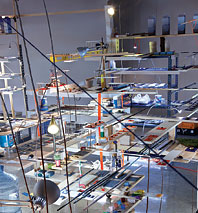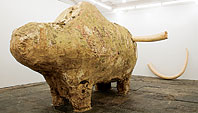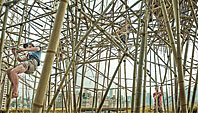The Year in Art
By Jerry Saltz

1. “Chaos and Classicism: Art in France, Italy, and Germany, 1918–1936”
At the Guggenheim Museum through January 9, 2011
It’s not often that a show pulls back the curtain on conventional wisdom or revises art history outright. But guest curator Kenneth Silver has done that with panache. Thanks to his show, we have a clearer, less formalist idea of what was going on across Europe between the wars. As we’ve long suspected, art didn’t simply march forward from Cubism in the teens through Dada and Surrealism in the twenties and thirties; it made some strange pit stops along the way, into an often disturbing realism. At the grand, terrifying end to this show—just yards from Olympia, Leni Riefenstahl’s ode to Teutonic superiority—is the work of one of Hitler’s favorite painters, Adolf Ziegler. That his triptych of four sinewy female nudes looks uncannily like the work of John Currin left me gasping about the present.
2. Tino Sehgal’s ‘This Progress’
Guggenheim Museum
You began the walk up the Guggenheim’s ramp—the walls stripped of art—accompanied by a child actor. At different stages, you were handed off to an older actor. As you progressed to the top, the talk was of progress; with each guide, the conversation would deepen or die, become more or less personal. What I loved? That Sehgal’s creation—as real as the Mona Lisa—offered such an expansive and moving (emotionally and physically) definition of art.
3. Heat Waves in a Swamp: The Paintings of Charles Burchfield”
Whitney Museum of American Art; curated by Robert Gober
It was a tremendous treat to rediscover the near-forgotten American visionary Burchfield, who turned ordinary things into eerie (ectoplasmic hills!), utterly original, even magical art. I much prefer the haunting, unknowable Burchfield to the Whitney’s main man of constant solitude, Edward Hopper.

4. Sarah Sze
Tanya Bonakdar Gallery
Sze went all out in this two-story-high gallery show, inhabiting the area with a madly replicating architecture of multiple parts (fans, lights, pieces of bicycles). Space was explored, expanded, slowed down, woven back together, and transformed into the abstract machine it may be.
5. Jessica Jackson Hutchins
Derek Eller Gallery and Laurel Gitlen
Hutchins is leading art into some fantastically promising places. With these two shows—“Kitchen Table Allegory” and “Over Come Over”—she turned abstraction and sculpture into imaginary fictions that are at once archaic, architectonic, filled with longing, and enchantingly awkward.

6. Joanna Malinowska, “Time of Guerrilla Metaphysics”
Canada
Her show opened at the end of 2009, but the physical presence, imaginative audacity, and sheer psychic power of Malinowska’s massive Boli figure—placed at the center of her excellent show—haunted me all year. The traditional tribal sculpture is made partially of excrement; the artist fabricated hers with wood, plaster, clay, and scraps of Spinoza’s Ethics.
7. Huma Bhabha, “Sculptures”
Salon 94 Bowery, through December 19
Bhabha’s formally inventive and rough sculptures of faces, bodies, fetishistic figures, and war machines conjure Roman antiquity and urban renewal, proving that serious high-mindedness doesn’t have to be freighted with bombast or bathos.

8. Mike and Doug Starn, “Big Bambú”
Metropolitan Museum of Art
The brothers took the roof of the Met and spun it into a gigantic, evolving nest crawling with viewers. Thrillingly participatory and experientially awesome, it never stopped growing—much like the museum itself.
9. Arlene Shechet, “The Sound of It”
Jack Shainman Gallery
It’s exciting to see artists using materials that, until recently, were ridiculed by the art world for being decorative or crafty. And somehow Shechet turned a variety of gnarly, curling, enigmatic (and oddly sexy!) objects into a convincing language of sculptural form.
10. “#class”
Winkleman Gallery
Just when we needed it, the spirit of activism, anarchy, and making it up as you go surfaced in this exhibition—a kind of think tank meets tribal gathering. Organized by artists Jennifer Dalton and William Powhida, “#class” was open to anyone who wanted to see performances, or talk about the market, careerism, and bad critics. Consciousness and hackles were raised; energy was generated.
This article is from: http://nymag.com/arts/cultureawards/2010/69899/

No comments:
Post a Comment